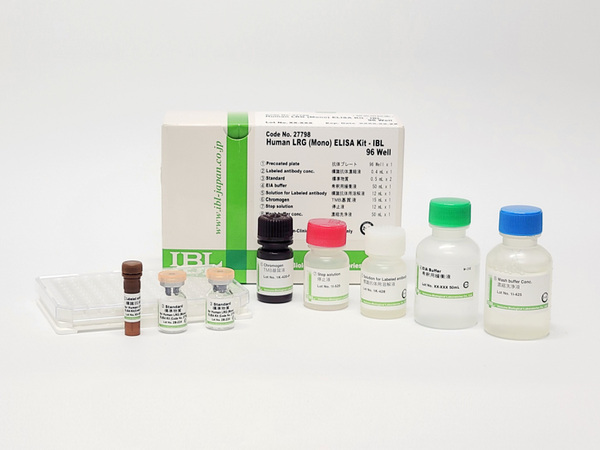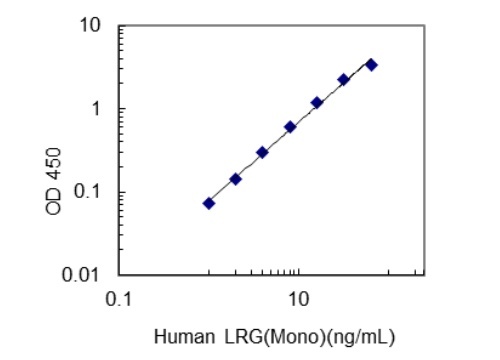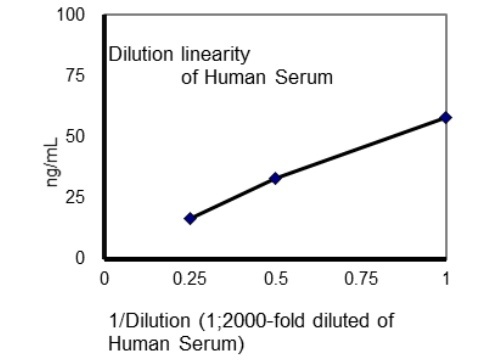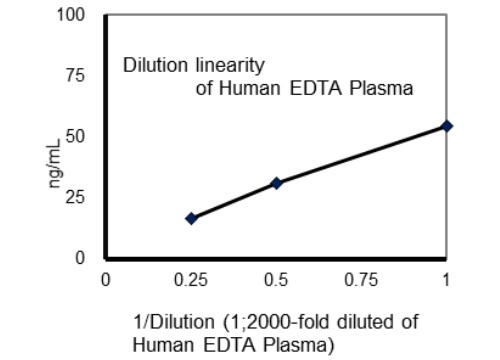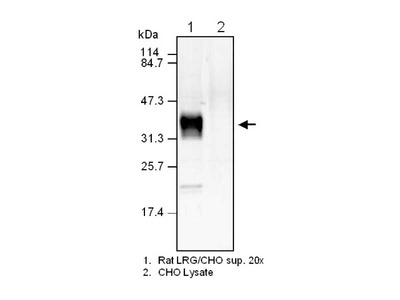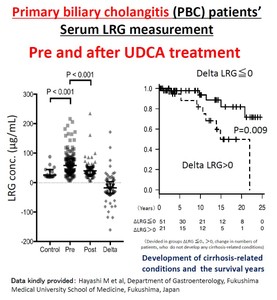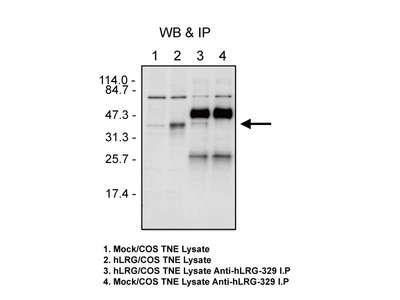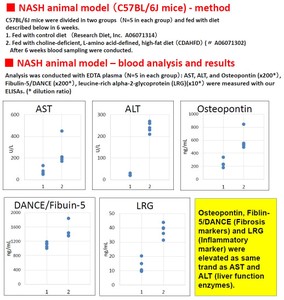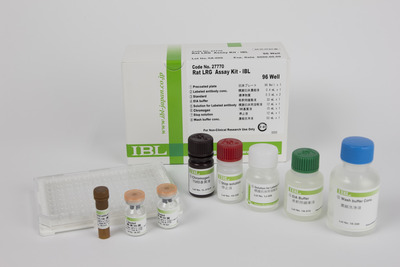- HOME >
- For Researchers >
- Product Search >
- Search Result >
- #27798 Human LRG (Mono) ELISA - IBL
Product Search
#27798 Human LRG (Mono) ELISA - IBL
- Intended Use:
- Research reagents
- Measuring Method:
- ELISA
- Sample Types:
- Human
- Measuring Samples:
- Human serum and EDTA plasma. (※ Additional EIA buffer may be required. The EIA buffer is available with charge. Please refer to the datasheet for the details.)
- Measurement Range:
- 1 ~ 64 ng/mL
- Package Size1:
- 96 Well
※ The product indicated as "Research reagents" in the column Intended Use cannot be used
for diagnostic nor any medical purpose.
※ The datasheet listed on this page is sample only. Please refer to the datasheet
enclosed in the product purchased before use.
Product Overview
Product Overview
| Product Code | 27798 |
|---|---|
| Product Name | Human LRG (Mono) ELISA Kit - IBL |
| Maker Name | Immuno-Biological Laboratories Co., Ltd. |
| Intended Use | Research reagents |
| Measuring Method | ELISA |
| Conjugate | HRP |
| Species | Human |
| Measuring Samples | Human serum and EDTA plasma. (※ Additional EIA buffer may be required. The EIA buffer is available with charge. Please refer to the datasheet for the details.) |
| Measurement Range | 1 ~ 64 ng/mL |
| Primary Reaction | 60 minutes at 37 °C |
| Secondary Reaction | 30 minutes at 2~8 ℃ |
| Sensitivity | 0.06 ng/mL |
| Specificity | Specifically detect Human LRG in human serum or EDTA-plasma. |
| Storage Condition | 2 - 8 ℃ |
| Poisonous and Deleterious Substances | Not Applicable |
| Cartagena | Not Applicable |
| Measuring Service | Not Available |
| Package Size 1 | 96 Well |
| Remarks1 | ※ Additional EIA buffer may be required. The EIA buffer is available with charge. Please refer to the datasheet for the details. The product is available with charge when more buffers are required. Please note, this buffer can be only used for #27798. Please DO NOT USE for Mouse or Rat LRG Assay Kits since the composition is different. Product Code: 27798D100 Product Name: Human LRG (Mono) EIA buffer 100 Size: 100 mL |
Product Description
Product Description
Leucine rich alpha2-glycoprotein (LRG) is one of leucine-rich repeat family proteins. LRG has been shown to be involved in protein-protein interaction, signal transduction, and cell adhesion and development. Recently, it was reported that serum levels of LRG were significantly elevated in Rheumatoid arthritis (RA) patients compared to healthy controls and decreased after anti-TNF therapy. Another report indicates serum LRG levels are elevated in other inflammatory diseases compared to healthy controls. LGR is expected as an inflammatory marker in various inflammatory diseases.
The ELISA kit correlates significantly the current product and have benefits of shorter assay time and higher sensitivity than the current product. The current product will be discontinued when the stocks lasts.
FAQ
FAQ
-
 Q.What is the expression of the standard?
Q.What is the expression of the standard? -
 A.It is a recombinant protein expression, which used CHO cells.
A.It is a recombinant protein expression, which used CHO cells. -
 Q.What is the recommended dilution factor for serum?
Q.What is the recommended dilution factor for serum? -
 A.The suitable dilution factor may vary by the condition, but we generally use around x5,000 for the measurements.
A.The suitable dilution factor may vary by the condition, but we generally use around x5,000 for the measurements. -
 Q.What are the epitopes of the plate-coated antibody used in this kit?
Q.What are the epitopes of the plate-coated antibody used in this kit? -
 A.Antibody is from recombinant protein antigen. No epitope mapping has conducted.
A.Antibody is from recombinant protein antigen. No epitope mapping has conducted. -
 Q.What is the epitope of the labeled antibody?
Q.What is the epitope of the labeled antibody? -
 A.Antibody is from recombinant protein antigen. No epitope mapping has conducted.
A.Antibody is from recombinant protein antigen. No epitope mapping has conducted. -
 Q.Are normal controls measurement data and reproducibility data available?
Q.Are normal controls measurement data and reproducibility data available? -
 A.Yes, we have. The date is available on the following product page. Please refer to the Pamphlet 2 listed on the page.
A.Yes, we have. The date is available on the following product page. Please refer to the Pamphlet 2 listed on the page.
http://www.ibl-japan.co.jp/en/search/product/detail/id=5671 -
 Q.Does this kit specifically detect LRG1 or other LRG families as well?
Q.Does this kit specifically detect LRG1 or other LRG families as well? -
 A.We have not checked the cross reactivity against other LRG families using our LRG-1 kit (#27798).
A.We have not checked the cross reactivity against other LRG families using our LRG-1 kit (#27798). -
 Q.Is composition of EIA buffer of each ELISA kit all same? Can it be mixed to use?
Q.Is composition of EIA buffer of each ELISA kit all same? Can it be mixed to use?
ELISA common FAQ -
 A.No it isn't. As constitute of each EIA buffer is different, it cannot be mixed with other lots or EIA buffers contained in other kind of ELISA kits.
A.No it isn't. As constitute of each EIA buffer is different, it cannot be mixed with other lots or EIA buffers contained in other kind of ELISA kits. -
 Q.What is the composition of concentrated wash buffer?
Q.What is the composition of concentrated wash buffer?
ELISA common FAQ -
 A.It contains ordinary Tween and phosphate buffer (0.05% Tween-20 in PB).
A.It contains ordinary Tween and phosphate buffer (0.05% Tween-20 in PB). -
 Q.What is the feature of the plate?
Q.What is the feature of the plate?
ELISA common FAQ -
 A.We use plate that is flat bottom and removable strip type plate (8wellx 12 strips).
A.We use plate that is flat bottom and removable strip type plate (8wellx 12 strips). -
 Q.Can I re-use standard after reconstitution?
Q.Can I re-use standard after reconstitution?
ELISA common FAQ -
 A.Not recommended to re-use standard after reconstitution. Please use it at once after the reconstitution.
A.Not recommended to re-use standard after reconstitution. Please use it at once after the reconstitution.
Please note that there are some exceptions. One time freeze-thaw the standard is acceptable for use after reconstitution for some ELISAs.
Please check the details on each product datasheet. -
 Q.What is different between reagent blank and test sample blank?
Q.What is different between reagent blank and test sample blank?
ELISA common FAQ -
 A.Reagent blank means a well is only added EIA buffer and the purpose is confirming whether the Test sample value is influenced by lack of washing process or other operations. Test sample blank means a well is added EIA buffer and HRP antibody and the purpose is to calculate the background.
A.Reagent blank means a well is only added EIA buffer and the purpose is confirming whether the Test sample value is influenced by lack of washing process or other operations. Test sample blank means a well is added EIA buffer and HRP antibody and the purpose is to calculate the background. -
 Q.How many samples can be measured by this kit?
Q.How many samples can be measured by this kit?
ELISA common FAQ -
 A.The pre-coated plate contained in our ELISA kit is 96 wells plate. We recommend to use 16 wells (2 slits) for standard and 80 wells (10 slits) for 40 samples in duplicate.
A.The pre-coated plate contained in our ELISA kit is 96 wells plate. We recommend to use 16 wells (2 slits) for standard and 80 wells (10 slits) for 40 samples in duplicate. -
 Q.What is LOD (Limit of Detection)?
Q.What is LOD (Limit of Detection)?
ELISA common FAQ -
 A.It (LOD) is defined as sensitivity that is calculated using the NCCSL method. Please refer to a datasheet of each product.
A.It (LOD) is defined as sensitivity that is calculated using the NCCSL method. Please refer to a datasheet of each product. -
 Q.What is LOQ (Limit of Quantification)?
Q.What is LOQ (Limit of Quantification)?
ELISA common FAQ -
 A.It (LOQ) is the lowest value of measurement (standard) range. Please refer to a datasheet of each product.
A.It (LOQ) is the lowest value of measurement (standard) range. Please refer to a datasheet of each product. -
 Q.What is the definition of Over Night (O/N) reaction?
Q.What is the definition of Over Night (O/N) reaction?
ELISA common FAQ -
 A.It means that the reaction is required more than 16 hours unless otherwise specifically defined it on a datasheet of each ELISA product.
A.It means that the reaction is required more than 16 hours unless otherwise specifically defined it on a datasheet of each ELISA product. -
 Q.What is the specification of quality control for ELISA product release?
Q.What is the specification of quality control for ELISA product release?
ELISA common FAQ -
 A.The information of specification is available on individual lot specific CoA. Please contact us with your reference lot number for obtaining of specific CoA.
A.The information of specification is available on individual lot specific CoA. Please contact us with your reference lot number for obtaining of specific CoA. -
 Q.What is the number (e.g. 432143214321) at the edge of strips of the plate?
Q.What is the number (e.g. 432143214321) at the edge of strips of the plate?
ELISA common FAQ -
 A.According to the plate maker (ThermoFisher), it does not have any specific meaning as it is just the number of molds.
A.According to the plate maker (ThermoFisher), it does not have any specific meaning as it is just the number of molds. -
 Q.How to wash an ELISA plate?
Q.How to wash an ELISA plate?
ELISA common FAQ -
 A.Washing it by an auto-washer is highly recommended.
A.Washing it by an auto-washer is highly recommended.
If it is not available, please refer to the demo video (only 2 mins) using a washing bottle. -
 Q.The wells turned black during the test with the kit.
Q.The wells turned black during the test with the kit.
ELISA common FAQ -
 A.It is possible that the wells were not washed sufficiently during the washing process after the HRP-labeled antibody reaction.
A.It is possible that the wells were not washed sufficiently during the washing process after the HRP-labeled antibody reaction.
Be sure to wash the wells enough times as described in the data sheet with washing buffer of more than 350 µL.

